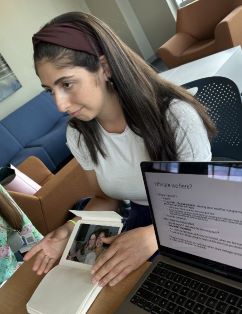LE WELL: Happiness Journaling 7/24/2024

“Choose happiness.”

Amanda Kahn with a journal at the start of the Happiness Journal session 7/24/2024
Second-year MD program student Amanda Kahn explains that she started the habit of journaling with a specific goal of highlighting the positives back on August 27, 2019, inspired by a journal her late aunt kept during her treatment of lung cancer. Amanda’s aunt underwent arduous therapies and shouldered significant pain during her battle with cancer, which made the positive messages Amanda read in her aunt’s journal even more poignant. Building and maintaining a practice of documenting the positives in each day – for what is now approaching five years – Amanda notes that she has observed a shift in the way she experiences life and processes her past as well as increased resilience in the face of burn out through “Happiness journaling.”
How does one go about setting up a Happiness Journal? Amanda recommends setting up a practice and adhering to it for at least three weeks (enough time to make a habit) while also acknowledging factors that will promote sustainability. For Amanda, this means setting aside time at least once per week to intentionally think through each day that has transpired since she last wrote in her journal (she finds the calendar app and photos on her smart phone to be particularly helpful in jogging her memory) and write about the positive events or feelings from each and every day.
What are some possible benefits of a Happiness Journaling practice?
- Shifting to a positive mind frame. Amanda notes that she has been overall happier and more grounded since starting this practice. Over the course of the last five years, Amanda has worked to develop a reflex for seeing the positives in each day, even when initially her first thought is not happy or grateful. She gives specific examples of some journal entries that are not initially positive and says that when she finds those entries she puts a line through the negative thought and rewrites it. For instance: “I didn’t spend a lot on meals which was great because the budget is tight” transformed to: I didn’t spend a lot on meals which was fantastic for the budget! “I am happy our friendship has maintained very well despite me moving” reframed to “I am happy our friendship has maintained very well over the last year!”
- Self-awareness. Through years of Happiness Journaling practice Amanda has noticed themes with activities that bring her joy – and now ensures she does some of these activities every day. Through the ritual of Happiness Journaling, you can learn about yourself, and can give yourself permission to do something for yourself, even if you are having a very tough day.
- Connection. Amanda notes that reading past entries involving other people frequently causes her to reflect with gratitude upon those people and that she is likely to reach out via phone call or text message to connect with those people when she comes across those anecdotes. She also notes that she has established connections with friends, classmates and supervisors through shared journaling practices.
- Honoring the memory of a loved one. Amanda places a photograph of herself with her aunt at the back of each of her Happiness Journals, along with the quote (from her aunt’s journal), “Choose Happiness.” Every time she opens her journal she is reminded of the positive memories she holds of her aunt. She recommends that novice journal-keepers starting a practice of “Happiness Journaling” find an inspiring photograph, piece of artwork, poem, or other meaningful image to place in their journal to serve as a focal point.
Does everyone journal in the same way? No! Amanda invited second-year child and adolescent psychiatry fellow Dr. Megan Single to explain her own journaling practices, which consist of writing down everything that happens in an effort to process hard days or difficult emotions and also in the service of future recollection and writing.
What are some possible drawbacks of a Happiness Journal? Amanda acknowledges that “toxic positivity,” or the kind of practice that invalidates lived hardships or negates challenging experiences, can be harmful. She notes that, while she disciplines herself to keep only positive thoughts in her Happiness Journal, she has “other places” for negative thoughts.
How can you build a sustainable process of positive reflection? For some, waking up early and making a point to journal might work well. For others, finding friends to join in the practice might be useful. Amanda notes that she has had success with setting reminders, setting the mood (e.g., with candles or music), and including trusted friends.
Are you interested in starting a Happiness Journal or keeping connection with others who are engaged in this practice? Amanda Kahn, MS2 (Amanda.Kahn@duke.edu) graciously offers her services for encouragement and ideas.

Amanda Kahn maintains connection with her late aunt, who inspired her Happiness Journaling practice, by keeping the journal and by maintaining a photograph of her aunt and herself at the front of each of her Happiness Journals
Are you interested in contributing to or planning a Wednesday Wellness Workshop? Drs. Gagliardi and Bonner would love to hear from you! Please stop by Granola with Gagliardi (Wednesdays at 2 p.m., TSCHE 2nd floor; or Fridays 12 p.m., IPEC (ground floor), or email lewb@duke.edu with ideas or to set up a time to talk.
